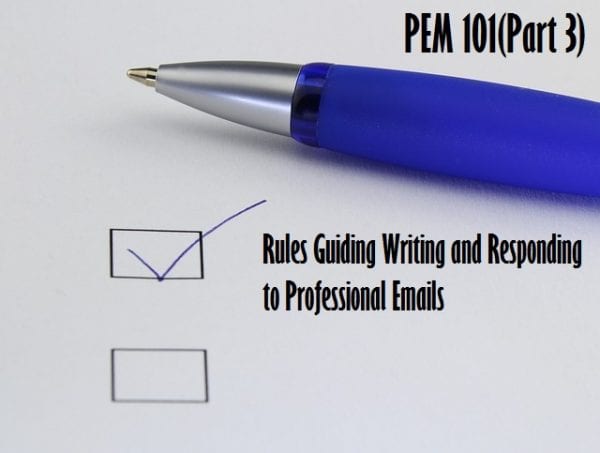Emails are still an integral part of business communication, and an effectual marketing tool if done right. That said, most emails fall by the wayside as they do not follow these simple steps to making them impactful. With no more ado, here are 13 steps to follow in order to write emails with real impact.
Time your response to perfection
Use 24 hours as the general rule of thumb when timing your email responses. Anything less may be a little rushed, so give yourself time to process and plan a response, while anything more may seem impolite, or worse, inefficient. Get your timing down to perfection with a structured approach to prioritising too.
“I use a system whereby anything urgent gets responded to as quickly as possible, while everything else gets parked for response for the next day, even though I will use the rest of the original day to action anything required within the email request. Good judgement is key, rather than a rigid approach, but this concept has always worked well for me,” recommends Iain Tomlinson, a project manager at Brit student and Australia2write.
Emails are not the only way
Emails are not the answer to every solution. Sending out emails in every circumstance is absolutely not the right approach. Think carefully if a phone call, or even an in-person visit would be more suitable in the circumstance. You can always follow up that conversation with a quick email for records purposes.
Use out-of-office
Following on from timing your response, and definitely not waiting too long, always use out-of-office messages when you are…out of the office, or otherwise engaged. This lets people know where they stand, and not become offended by a failure to reply. Be succinct and concise in your message, letting people know when you will return, and giving any details of others that can be contacted in your absence
Get to the point
No one wants to open an email and be met by paragraph upon paragraph of text. Keep emails on point, and keep them concise, which means setting out what you want to say early, but…
Be polite
Keeping emails concise but polite is a skill. The problem with brevity is that, if done incorrectly, it can come across as curt and impolite, even if that is not the intention at all. Learn the most effective salutations to use, don’t forget your ‘pleases’ and ‘thank yous’, but you can still get to the point. Being brief is not the same as being impolite.
Never let emotion rule an email
Coming hand in hand with being polite is the rule of never letting emotion dictate your email style. To come across as professional, emotions must always be parked. If you are angry, take some time to cool off before sitting down to type. Likewise, if you are ecstatically happy, you may also want to let the emotion dampen slightly before gushing out your innermost feelings in an email.
“Remember the 24-hour rule, but taking a little time for your emotions to plateau is also good advice to follow. I always suggest walking away from your desk and taking a little fresh air, or turning your mind to a completely different activity for a little while before coming back to the email,” suggests Miriam Lipton, a marketer at Writemyx and Nextcoursework.
Tailor emails
Most people hate generic emails, and it is one of the fastest ways of turning them off your message. Avoid using ‘reply all’ unless completely necessary, and try to personalise your emails as much as possible. One efficient way of doing this, ensuring you don’t spend too much time personalising each and every email you send, is using a template which can be amended quickly and easily to appear much more tailored. Speaking directly to an individual through your communication is a sure-fire way of improving success rates.
Use a smart subject line
Think carefully about the subject of your email: after all, this may be the only part of the message that the receiver actually sees, depending on what they choose to do with it (open it or bin it are usual two options!) Make the heading interesting, relevant, and personalised if possible. Combining these three elements should lead to enough intrigue to open your email quickly.
Use a task tool
Very often an email is a call to action, requiring you to perform a task. Managing the tasks that are prescribed through emails can be a little tricky, and it is easy to miss something if you do not use a tried-and-tested system. Fortunately, these days there are a number of useful task tool assistants which can effectively track and organize the tasks given to you through emails. Gmail, for example, has a task tool that can be integrated with your emails, proving a helpful list of actions.
Use professional-looking ID and signatures
Think about the message that your email sends, and this includes how you present yourself at the end of your email with your ID and signature. If you have your own business, ensure that your ID conforms to your website style, or if you use in-house colour schemes, adhere to these. The more professional looking, the better.
Use a photo or image accompaniment
Using a photo ID can help immensely with credibility, and anything that can connect your face with your name is valuable. This may not always be possible, of course, but is increasingly important in creative industries.
Use an email address linked to your website
Using generic email addresses such as Gmail is fine unless you have a brand that you wish to promote. If your website is a strong part of that brand, then you absolutely must use an email handle that links to your website. Anything less is just unprofessional.
Reread your emails before sending
This is the most obvious recommendation on this list, but it is still incredible how many emails are sent out with basic typos and other mistakes which would easily have been rectified with a quick read through. Don’t fall into the trap of hitting ‘send’ before you reread your email.







